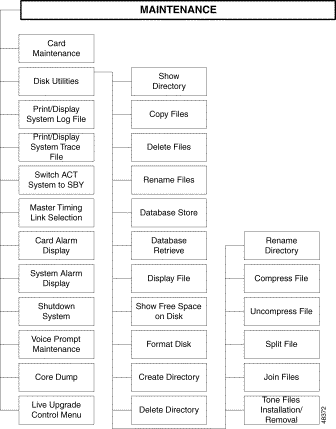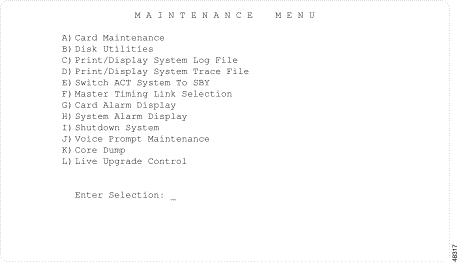|
|

The System Alarm Display indicates two resource limitation conditions that can impact TeleRouter performance. This display is accessed from the Maintenance Menu screen as shown in Figure 5-1.

To access the Maintenance Menu screen (see Figure 5-2) from the Main Menu screen, type C and press Enter.

The cursor is located in the Enter Selection data entry field. To access a function, type the letter that precedes it and press Enter. To return to the Main Menu, press Prev Menu, Main Menu, or Exit. The functions that can be accessed from this menu are discussed in the remainder of this chapter.
The System Alarms Display screen is used to view a listing of the alarm types present on the system. Refer to the Cisco VCO/4K System Administrator's Guide for details on the System Alarm Display function.
To access the System Alarms Display screen from the Maintenance Menu screen, type H and press Enter. The System Alarms Display screen is shown in Figure 5-3. The cursor is located in the Alarm Severity data entry field, and all current alarm conditions are listed.

The System Alarm Display can include multiple screens. Each screen lists up to 14 messages. Use the Print Screen key to obtain a hard copy of this screen. This screen is not dynamically updated. To update the display with the most recent alarms, press the Redraw key.
To return to the Maintenance Menu screen, press Exit or the Prev Menu key.
The System Alarms Display screen includes the following fields:
Alarm Severity—Data entry via Select key. Specifies the type of system alarms to display. Possible values and their meaning are as follows:
Audible Cutoff (Y,N)—Optional data entry via main keypad; command field. Specifies whether to disable the AAC alarm contact to stop any central offices alarms tied to the switch.
Alarm Descriptions—Display only. Indicates the alarm conditions present for the system. Possible values and their meanings are listed in Cisco VCO/4K System Messages.
Occurrences—Display only. Indicates the number of alarm occurrences.
To display current system alarm conditions, complete the following steps:
Step 1 Display the System Alarms Display screen.
The cursor is located in the Alarm Severity data entry field.
Step 2 Use the Select and Reverse Select keys to step through the values until the correct alarm severity is shown.
Step 3 Press Enter.
The display is updated to show all alarms and occurrences for the severity level chosen.
Step 4 Press Exit to return to the Maintenance Menu screen.
To leave the System Alarms Display screen, press Exit or the Prev Menu or Main Menu key.
Refer to Cisco VCO/4K System Messages for descriptions of alarms ALM015 and ALM016, which are set when the system is operating TeleRouter in a stand alone configuration.
![]()
![]()
![]()
![]()
![]()
![]()
![]()
![]()
Posted: Sat Sep 28 18:00:35 PDT 2002
All contents are Copyright © 1992--2002 Cisco Systems, Inc. All rights reserved.
Important Notices and Privacy Statement.